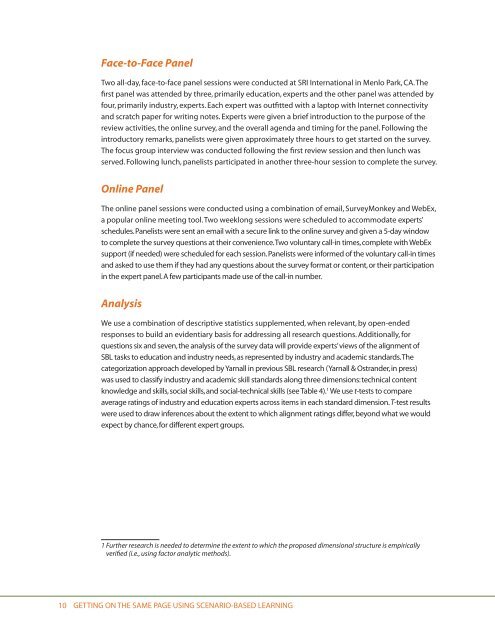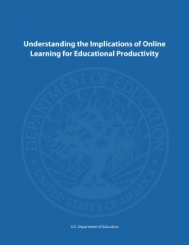Download PDF - SRI International
Download PDF - SRI International
Download PDF - SRI International
Create successful ePaper yourself
Turn your PDF publications into a flip-book with our unique Google optimized e-Paper software.
Face-to-Face Panel<br />
Two all-day, face-to-face panel sessions were conducted at <strong>SRI</strong> <strong>International</strong> in Menlo Park, CA. The<br />
first panel was attended by three, primarily education, experts and the other panel was attended by<br />
four, primarily industry, experts. Each expert was outfitted with a laptop with Internet connectivity<br />
and scratch paper for writing notes. Experts were given a brief introduction to the purpose of the<br />
review activities, the online survey, and the overall agenda and timing for the panel. Following the<br />
introductory remarks, panelists were given approximately three hours to get started on the survey.<br />
The focus group interview was conducted following the first review session and then lunch was<br />
served. Following lunch, panelists participated in another three-hour session to complete the survey.<br />
Online Panel<br />
The online panel sessions were conducted using a combination of email, SurveyMonkey and WebEx,<br />
a popular online meeting tool. Two weeklong sessions were scheduled to accommodate experts’<br />
schedules. Panelists were sent an email with a secure link to the online survey and given a 5-day window<br />
to complete the survey questions at their convenience. Two voluntary call-in times, complete with WebEx<br />
support (if needed) were scheduled for each session. Panelists were informed of the voluntary call-in times<br />
and asked to use them if they had any questions about the survey format or content, or their participation<br />
in the expert panel. A few participants made use of the call-in number.<br />
Analysis<br />
We use a combination of descriptive statistics supplemented, when relevant, by open-ended<br />
responses to build an evidentiary basis for addressing all research questions. Additionally, for<br />
questions six and seven, the analysis of the survey data will provide experts’ views of the alignment of<br />
SBL tasks to education and industry needs, as represented by industry and academic standards. The<br />
categorization approach developed by Yarnall in previous SBL research (Yarnall & Ostrander, in press)<br />
was used to classify industry and academic skill standards along three dimensions: technical content<br />
knowledge and skills, social skills, and social-technical skills (see Table 4). 1 We use t-tests to compare<br />
average ratings of industry and education experts across items in each standard dimension. T-test results<br />
were used to draw inferences about the extent to which alignment ratings differ, beyond what we would<br />
expect by chance, for different expert groups.<br />
1 Further research is needed to determine the extent to which the proposed dimensional structure is empirically<br />
verified (i.e., using factor analytic methods).<br />
10 GETTING ON THE SAME PAGE USING SCENARIO-BASED LEARNING
















